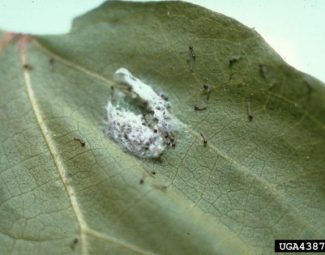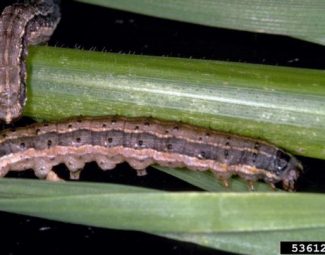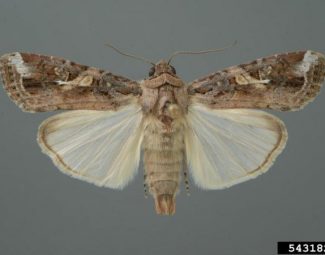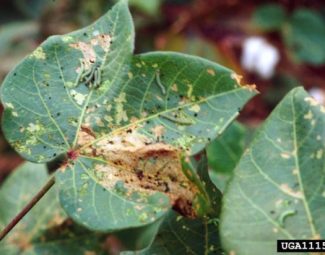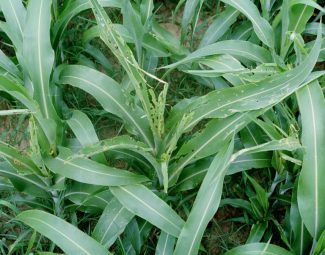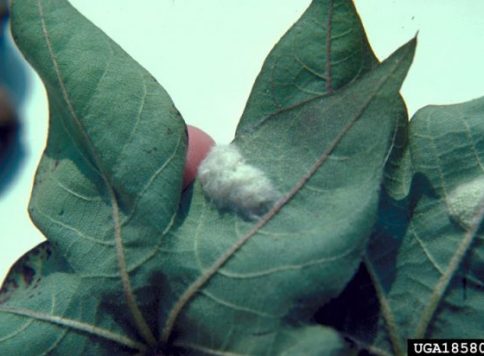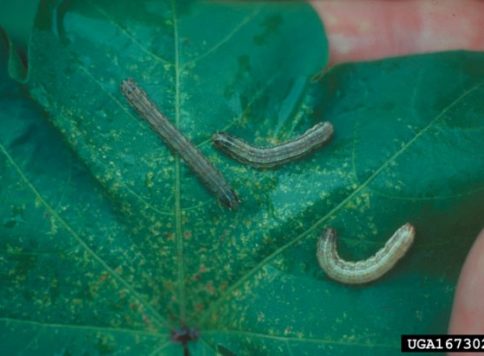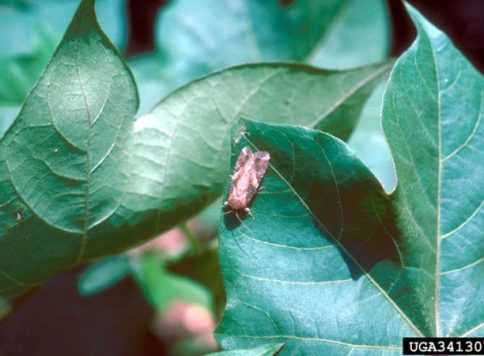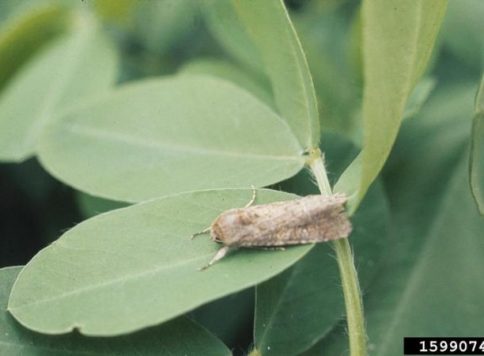Fall Armyworm
Insect Summary Report
Spodoptera frugiperda
General Information
- The Fall Armyworm has a wide range of at least 80 host species which include: alfalfa, apple, barley, buckwheat, cotton, clover, grape, flowers, millet, oat, orange, papaya, peach, peanut, ryegrass, strawberry, sugar beet, sudangrass, soybean, sugarcane, timothy, tobacco, and wheat.
- Prefer monocots such as corn, sorghum, bermudagrass, and rice. Certain strains of fall armyworm may show different preferences for hosts.
- Weeds that serve as hosts include: bentgrass, crabgrass, Digitaria ssp., Johnsongrass, morningglory, nutsedge, pigweed, and sandspur.
- Strong fliers. Migrate northward from over-wintering sites across North America as summer progresses.
- Mass migratory infestations can occur when preferred hosts are no longer available due to lack of moisture and other environmental conditions.
- Damage foliage and fruit of host plants by direct feeding. Can quickly cause severe defoliation when high population densities exist. Also capable of direct destruction and/or depletion of yield and yield quality. Capable of burrowing directly through husk of corn ears. Feeding damage increases susceptibility of host tissue to pathogens.
- In general, control measures are more effective on smaller larva than more advanced stages of development.
- Most prolific when over-wintering areas experience cool, wet springs that are followed by warm, humid conditions.
- Broad-spectrum, contact insecticide use may reduce natural controls and increase survival rates of armyworms.
- Uses sex pheromone for mating recognition.
Life Cycle (24-90 Days)
- Eggs… (2-5 Days) Dome shaped. Laid in mass groups of approx. 100-200. Grey, cottony appearance due to protective scales deposited by female moth on top and in between egg mass.
- Larva… (14-30 Days) 6 instars. Range from approx. 1-34 mm. Young instars are green with a black head that turns orange in the 2nd instar. Commonly are cannibalistic. Later instars turn brown and develop lines that run the length of the body on both sides and on top of the back. Raised dark spots appear that grow spiny hairs. Can be distinguished from bollworm larva by a smooth feeling epidermis, an inverted “Y” that develops on that head that can be seen when viewed from the front, and four dark spots at the end of the body. Some larva keep green coloration in later instars and have pale spots. Larva drop to ground to pupate.
- Pupa… (8-30 Days) Larva spin a loose cocoon made of surrounding soil and silk in top 2-6 cm. Red in color. May sometimes spin cocoon in leaf debris.
- Adult… (7-21 Days) Mottled tan, gray, brown or black in appearance with triangular white spots at the tip and center of the forewings. Female can lay up to 1500-2000 or more eggs. Mainly nocturnal. Most active during warm, humid nights. Lays eggs within 3-4 days of mating and can last up to 3 weeks. Most eggs are laid within the first 4-5 days.
Over-wintering Strategy
Usually over-winter as pupa, but very susceptible to cold temperatures. In warmer winter climates, may stay active throughout winter months and continue to generate populations.
Sampling
Pheromone and blacklight traps can be used to sample moth presence. Pheromone traps only attract male moths. Traps should be mounted at canopy level. If moths are detected, inspect plants for eggs and larva. Larva seek shelter during hottest parts of the day, so morning and evening hours are best suited for detection. Wet, tan balls of excrement are indication of armyworm feeding. Densities of less than 1 larva/corn plant in late whorl stage can reduce yields by 5-20%. Infestation during whorl stage causes regular holed appearance when leaves spread out.
Organic Control
- General Info
- Several native wasp and fly parasites serve as natural control in most areas. Various fungal and bacterial pathogens also serve as important natural controls.
- Naturally occurring predators of the fall armyworm eggs and larva include: various ground beetles, striped earwig, spined soldier bug, minute pirate bugs, lacewings, big-eye bugs, and damsel bugs as well as mammalian predators such as birds, raccoons, armadillos, and other grub feeders.
- Commonly Used Products
- Ferti-Neem Oil
- Ferti-Organics Karanja Oil
- Bt: Agree; Xentari; Dipel; Javelin
- Entrust (Spinosad)
- Neemix 4.5 (Botanical)
- BoteGHA ES (Biological)
Cultural Control
- Maintain good fertility and mineral balance in plants. Identify macro- and micro- nutrient deficiencies by performing plant tissue and soil analysis. Adjust for deficiencies with foliar and soil applied applications of appropriate fertilizers.
- Destroy vegetative materials and crop residue immediately after harvest.
- In forage and hay fields, cutting of vegetation can take the place of insecticide treatments. Leaving strips of uncut hay may reduce migration to adjoining fields and preserve natural controls.
- Early spring planting and/or early maturing varieties can encourage early harvest before populations build to economic thresholds.
More Images of the Fall Armyworm
Bibliography
- Images by Frank Peairs, Colorado State University, Bugwood.org (larva and larvae)
- Images by David Jones, University of Georgia, Bugwood.org (eggs on cotton plant and adult on plant)
- Images by William Lambert, University of Georgia, Bugwood.org (larvae on leaf, male adult, and eggs hatching)
- Images by Charles T. Bryson, USDA Agricultural Research Service, Bugwood.org (larva on bermudagrass and larvae on damaged cotton plant)
- Image by Ronald Smith, Auburn University, Bugwood.org (egg mass)
- Image by Clemson University – USDA Cooperative Extension Slide Series, Bugwood.org (damage to sorghum)
- Image by John Capinera, University of Florida, Bugwood.org (adult close up)
- Image by University of Georgia, University of Georgia, Bugwood.org (adult with larva)
- Image by John C. French Sr., Retired, Universities:Auburn, GA, Clemson and U of MO, Bugwood.org (adult)
- Image by Lyle Buss, University of Florida, Bugwood.org (adult – wings spread)
- http://creatures.ifas.ufl.edu/field/fall_armyworm.htm (Preferred hosts, life cycle)
- http://edis.ifas.ufl.edu/IG059 (conventional controls)
- http://www.ext.vt.edu/pubs/entomology/444-015/444-015.html (Weed hosts, host preference of different strains, cannibalism, trapping, migration)
- Marenco RJ, Foster RE, Sanchez CA. 1992. Sweet corn response to fall armyworm (Lepidoptera: Noctuidae) damage during vegetative growth. Journal of Economic Entomology 85: 1285-1292.

